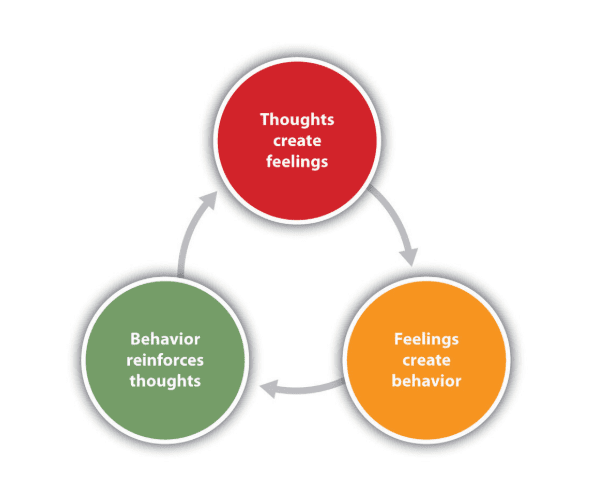The CBT Model explained
July 22, 2025 4:08 pm
Understanding the CBT model can be helpful for anyone seeking an effective way to manage conditions like anxiety or depression.
Cognitive Behavioural Therapy (CBT) is a structured, time-limited therapy that focuses on changing negative thought patterns to improve emotional responses and behaviour.
This blog will guide you through the fundamentals of CBT, its model, and how it can help you or a loved one navigate mental health challenges.
What is Cognitive Behavioural Therapy?
Cognitive Behavioural Therapy (CBT) is a therapeutic approach designed to help individuals understand and alter the negative thoughts and behaviours that contribute to psychological distress.¹ CBT focuses on the cognitive model, which suggests that our thoughts, feelings, and behaviours are interconnected.
When people experience negative emotions or distress, these are often triggered by negative or distorted thoughts. CBT aims to break this cycle and replace unhelpful thought patterns with healthier alternatives.
This approach is particularly effective for treating conditions such as anxiety, depression, and stress-related disorders², with research showing it to be one of the most evidence-based treatments available today.³
The CBT Model explained
The CBT model is a framework used in therapy that connects thoughts, emotions, behaviours, and physical sensations in a cycle.
The idea is that by identifying and changing negative thought patterns, individuals can improve their emotional responses and behaviours.
Understanding each element of the CBT model helps clients break free from unhelpful cycles and foster positive change. Let’s explore the main components of the CBT model in more detail.
Situation
The first component of the CBT model is the “situation.” This refers to an event or trigger that sets off the cycle of thoughts, feelings, and behaviours.⁴
Situations can be external, like receiving negative feedback at work, or internal, such as recalling a past event. By identifying the situation that sparks a negative thought cycle, CBT allows individuals to evaluate how they are perceiving the event.
For example, an individual might think, “I’m going to fail at this task,” when faced with a challenging situation.
Automatic thoughts
Next in the CBT cycle are automatic thoughts, which are quick, often subconscious thoughts that arise in response to a situation.⁴
These thoughts are typically negative and unhelpful, which is why CBT focuses on identifying and challenging them. For example, after the situation at work, the automatic thought might be, “I’m not good enough.”
These thoughts tend to exaggerate the negative, reinforcing feelings of hopelessness and anxiety.
Emotions
In the CBT cycle, emotions are typically driven by the automatic thoughts that follow a situation.⁴ For instance, thinking, “I’m going to fail”, can lead to feelings of anxiety, sadness, or fear.
These emotions can have a profound effect on an individual’s mental health and can influence how they behave.
By challenging the thoughts that contribute to negative emotions, individuals can begin to feel more in control of their emotional state, rather than being overwhelmed by it.
Behaviours
Behaviours are the final component in the CBT model. In response to negative thoughts and emotions, individuals often engage in certain behaviours that can reinforce their distress.
These behaviours can be avoidance, isolation, or even self-criticism.⁴ For example, someone feeling anxious about work might procrastinate or avoid a challenging task. CBT focuses on modifying these behaviours by addressing the underlying thought patterns and emotions.
A key goal of CBT work is to help clients replace unhelpful behaviours with healthier coping strategies, such as problem-solving or seeking support.

What are cognitive distortions?
Cognitive distortions are irrational or biased ways of thinking that can perpetuate negative emotions and behaviours.⁵
These distortions often arise automatically, leading individuals to interpret situations in an exaggerated, unhelpful manner.
Some common cognitive distortions include catastrophising (expecting the worst outcome), all-or-nothing thinking, and overgeneralising. CBT aims to challenge these distortions and replace them with more balanced, rational thoughts.
Principles of treatment under the CBT Model
CBT operates under several key principles that guide its treatment. These principles help ensure that the therapy remains effective, structured, and focused on achieving lasting change.
1. CBT constantly reviews client progress
A core principle of the CBT model is regular progress reviews. This ensures that clients are actively engaged in their treatment, allowing therapists to assess the effectiveness of strategies and make necessary adjustments.
The constant evaluation of progress ensures that CBT remains relevant and effective in addressing the client’s needs.
2. CBT is a collaborative process
In CBT, the therapist and client work together as a team. The therapist provides guidance, but the client is responsible for implementing techniques and strategies.
This collaborative approach fosters a sense of empowerment, as clients learn to manage their thoughts, emotions, and behaviours independently.⁶
Research around the CBT Model: Is it effective?
Research consistently supports the efficacy of the CBT model as a highly effective, evidence-based treatment for many mental health conditions.³
Strengths of the CBT Model
Strong empirical support
One of the main strengths of the CBT model is its robust evidence base. Numerous studies have shown that CBT is effective in treating a wide range of mental health conditions, including anxiety⁷, depression⁸, and phobias⁹.
The clear structure and focus on practical solutions make it a valuable therapy for those seeking improvement.
Focus on skill-building
Another strength of the CBT model is its emphasis on building practical skills. Clients learn how to identify negative thoughts, challenge cognitive distortions, and develop healthier coping strategies.
This empowers individuals to manage their mental health long after therapy has ended.
Limitations of the CBT Model
Requires active participation
One limitation of the CBT model is that it requires clients to actively engage in the process. This can be challenging for individuals who struggle with motivation or those facing severe emotional distress.
However, with the right support, clients can gradually learn how to manage their thoughts and behaviours effectively.
Not always suitable for everyone
While CBT is highly effective for many, it may not be the best approach for individuals with certain complex conditions or those who require a more in-depth therapeutic approach.¹⁰
Book a CBT session with our psychologist in Newcastle
If you’re interested in learning more about the CBT model and how it can help you, our experienced psychologists at
Chiropractic Plus can guide you through the process, should this be the right treatment for you.
Take the first step towards feeling better today. Visit our Psychology and Anxiety pages for more information, or contact us to schedule an appointment.
References
- Beck, J. S., & Fleming, S. (2021, June 18). A brief history of Aaron T. Beck, MD, and Cognitive Behavior Therapy. Clinical Psychology in Europe, 3(2). https://doi.org/10.32872/cpe.6701
- Cuijpers, P., Cristea, I. A., Karyotaki, E., Reijnders, M., & Huibers, M. J. (2016). How effective are cognitive behavior therapies for major depression and anxiety disorders? A meta-analytic update of the evidence. World Psychiatry, 15(3), 245–258. https://doi.org/10.1002/wps.20346
- David, D., Cristea, I., & Hofmann, S. G. (2018). Why cognitive behavioral therapy is the current gold standard of psychotherapy. Frontiers in Psychiatry, 9, 4. https://doi.org/10.3389/fpsyt.2018.00004
- Beck, J. S. (1997). Cognitive therapy: Basics and beyond. Journal of Psychotherapy Practice and Research, 6(1), 71–80. https://www.ncbi.nlm.nih.gov/pmc/articles/PMC3330449/
- Yurica, C. L., & DiTomasso, R. A. (2005). Cognitive distortions. In A. Freeman, S. H. Felgoise, C. M. Nezu, A. M. Nezu, & M. A. Reinecke (Eds.), Encyclopedia of cognitive behavior therapy (pp. 101–105). Springer. https://doi.org/10.1007/0-306-48581-8_36
- Wilmots, E., Midgley, N., Thackeray, L., Reynolds, S., & Loades, M. (2020). The therapeutic relationship in cognitive behaviour therapy with depressed adolescents: A qualitative study of good-outcome cases. Psychology and Psychotherapy: Theory, Research and Practice, 93(2), 276–291. https://doi.org/10.1111/papt.12232
- Cuijpers, P., Sijbrandij, M., Koole, S. L., Huibers, M. J. H., Berking, M., & Andersson, G. (2014). Psychological treatment of generalized anxiety disorder: A meta-analysis. Clinical Psychology Review, 34(2), 130–140. https://doi.org/10.1016/j.cpr.2014.01.002
- Barth, J., Munder, T., Gerger, H., Nüesch, E., Trelle, S., Znoj, H., Jüni, P., & Cuijpers, P. (2013). Comparative efficacy of seven psychotherapeutic interventions for patients with depression: A network meta-analysis. PLoS Medicine, 10(5), e1001454. https://doi.org/10.1371/journal.pmed.1001454
- Galvão-de Almeida, A., de Araujo Filho, G. M., Berberian, A. A., Trezsniak, C., Nery-Fernandes, F., Araujo Neto, C. A., Jackowski, A. P., Miranda-Scippa, Â., & de Oliveira, I. R. (2013). The impacts of cognitive-behavioral therapy on the treatment of phobic disorders measured by functional neuroimaging techniques: A systematic review. Brazilian Journal of Psychiatry, 35(3), 279–283. https://doi.org/10.1590/1516-4446-2012-0922
- Iacobucci, G. (2024, September 6). CBT is an effective treatment for many mental health issues – but here’s why it may not suit everyone. Brunel University London. Retrieved July 1, 2025, from https://www.brunel.ac.uk/news-and-events/news/articles/CBT-is-an-effective-treatment-for-many-mental-health-issues-%E2%80%93-but-here’s-why-it-may-not-suit-everyone































